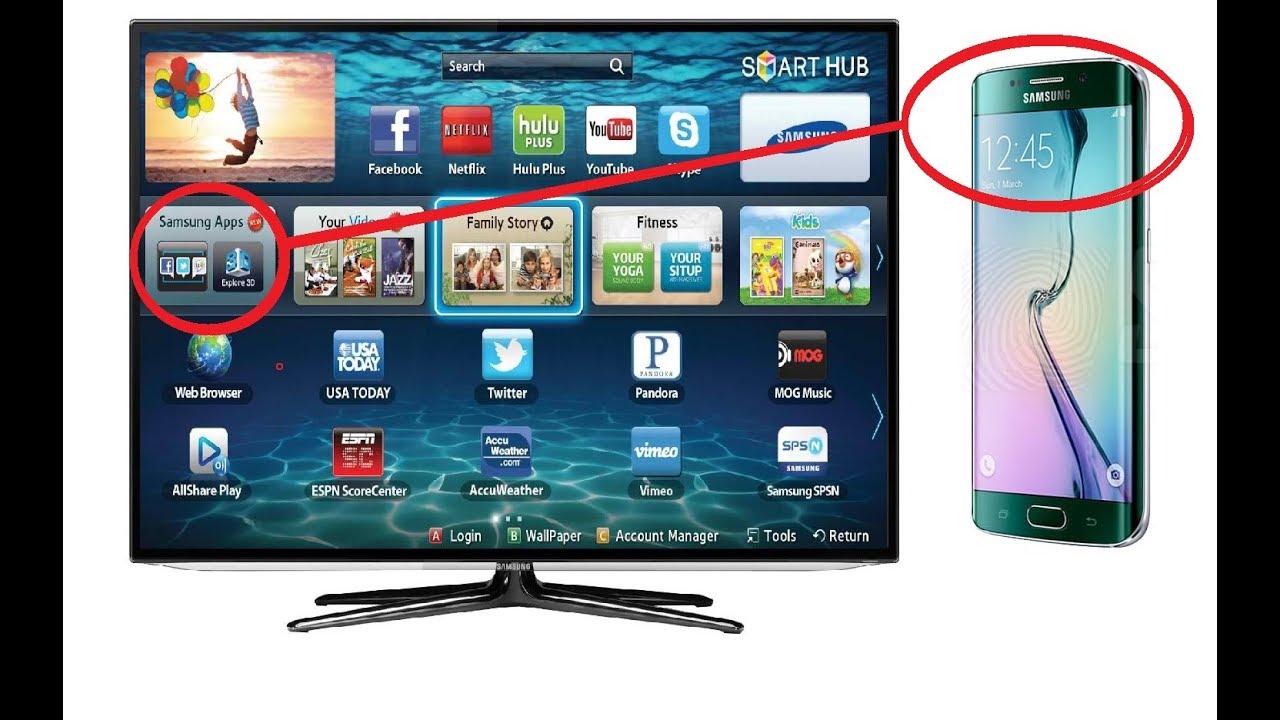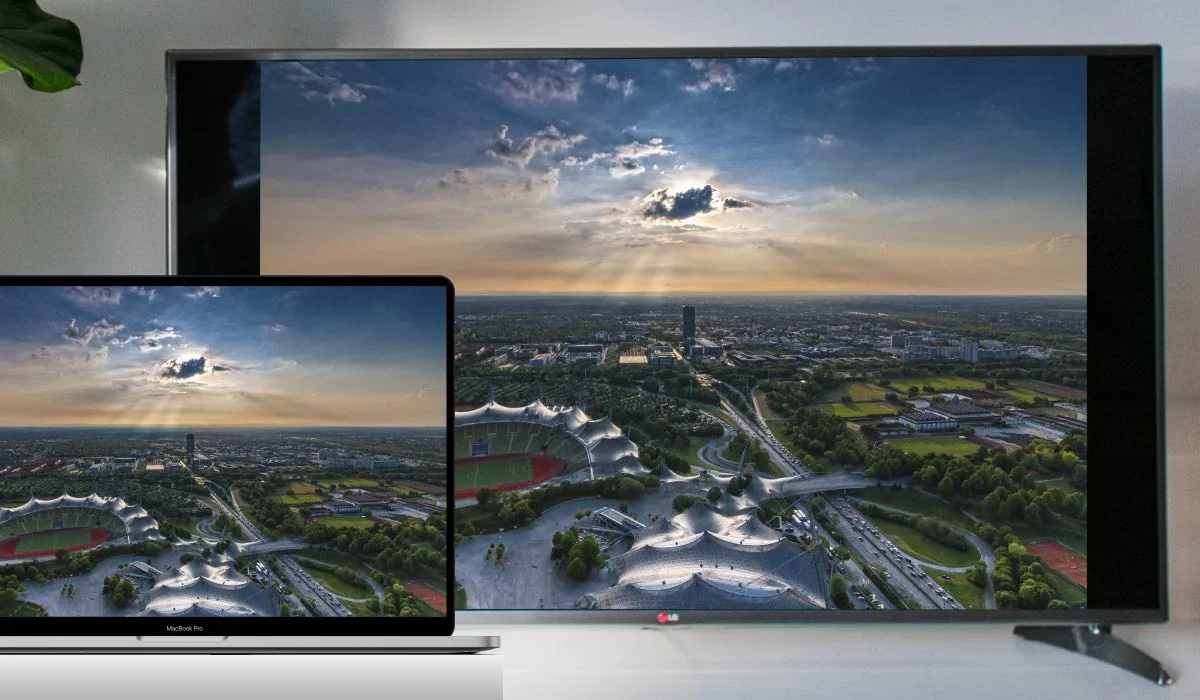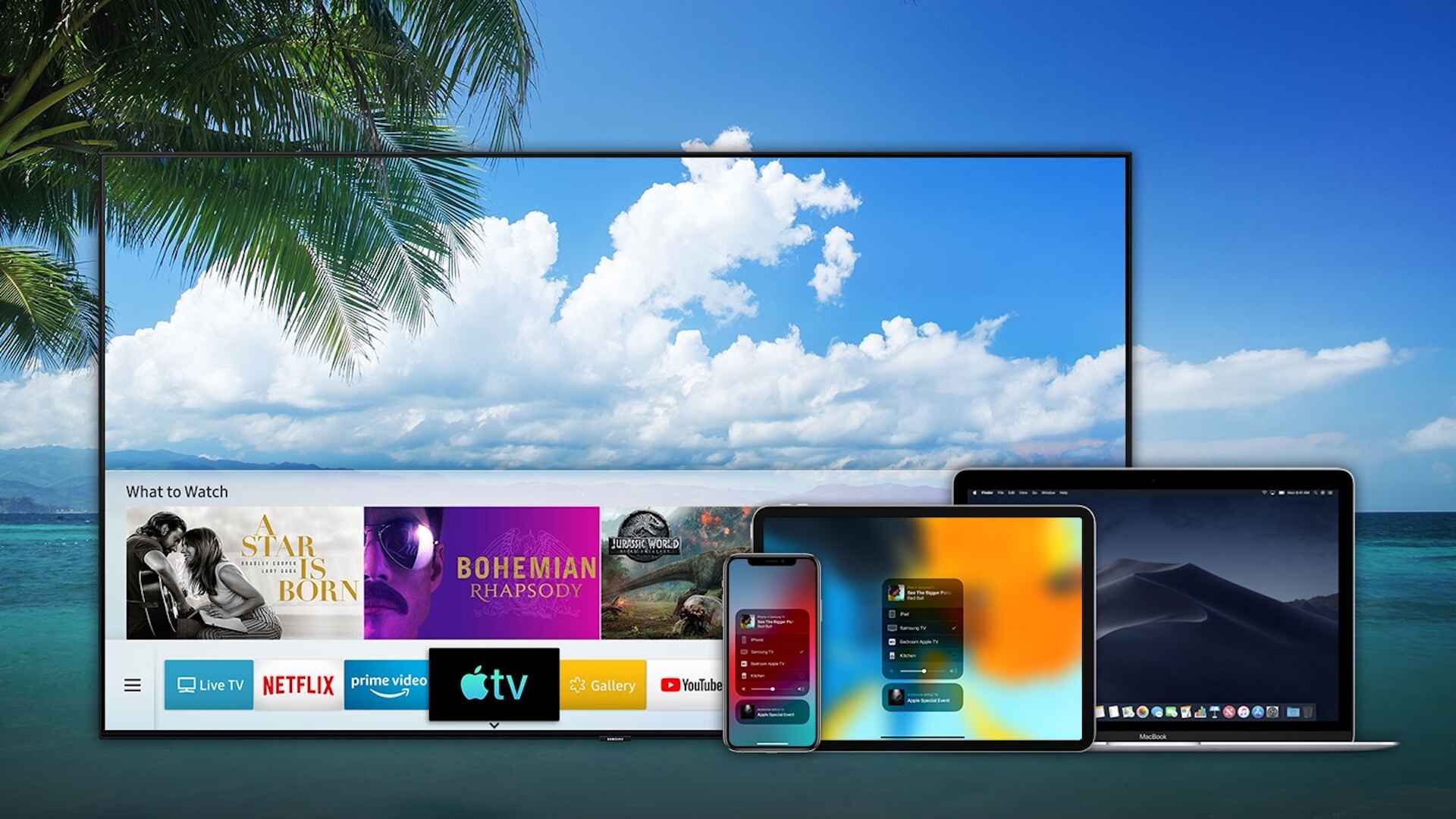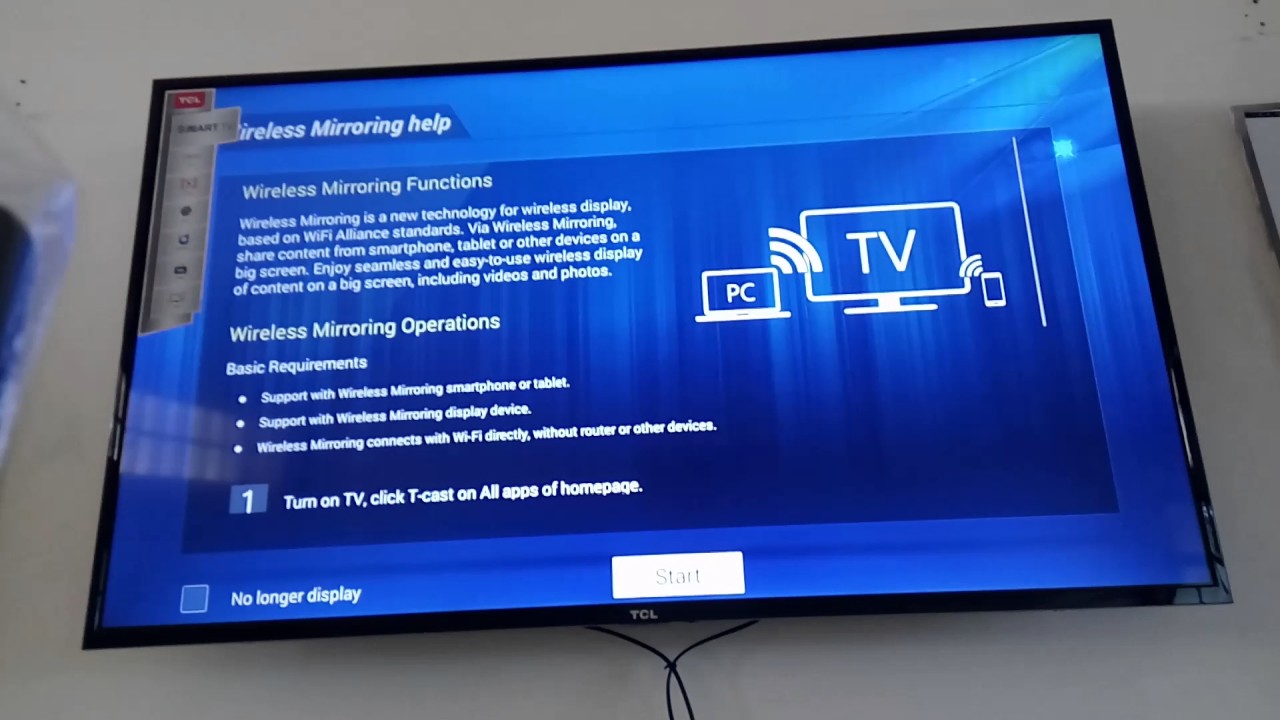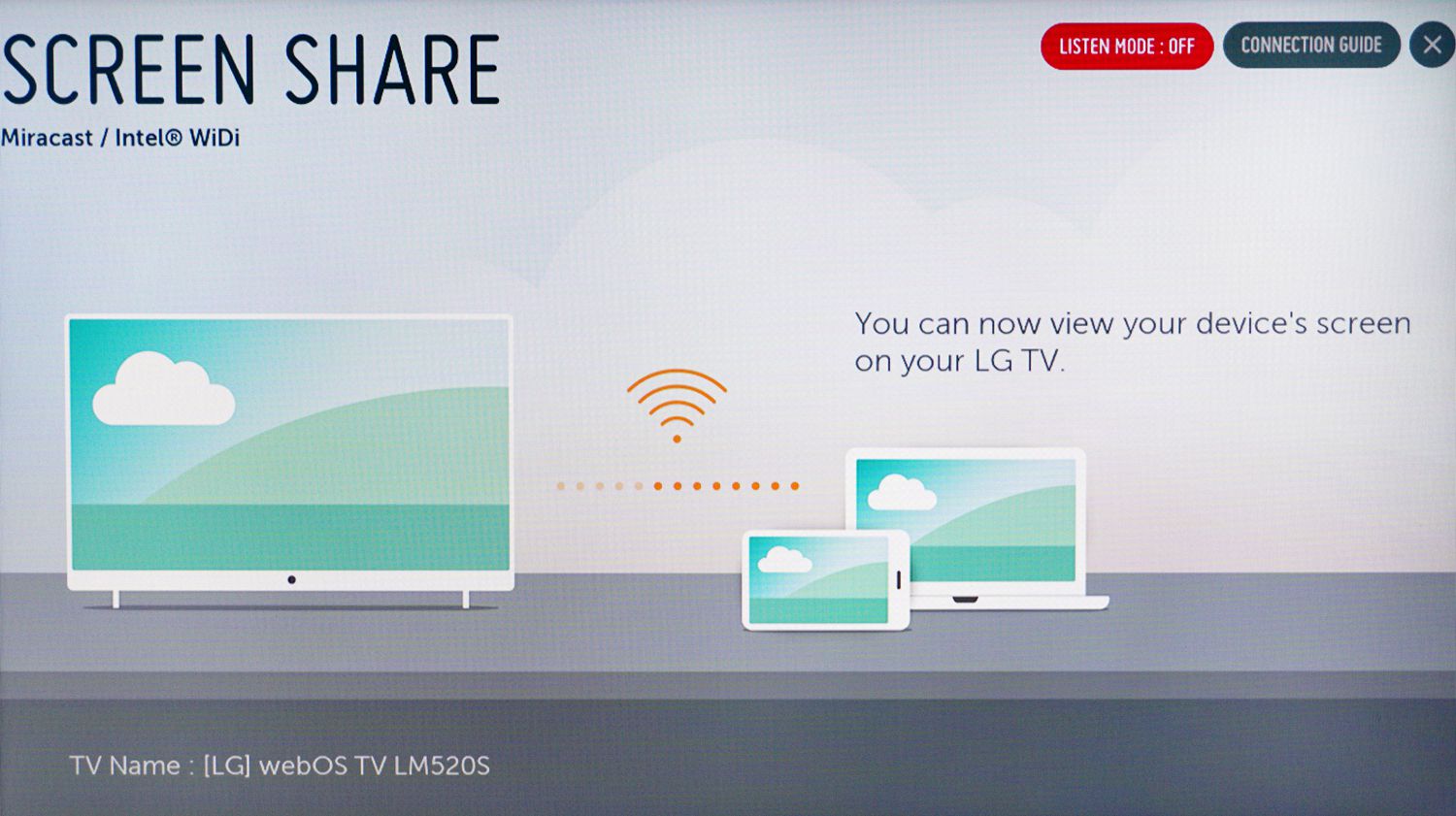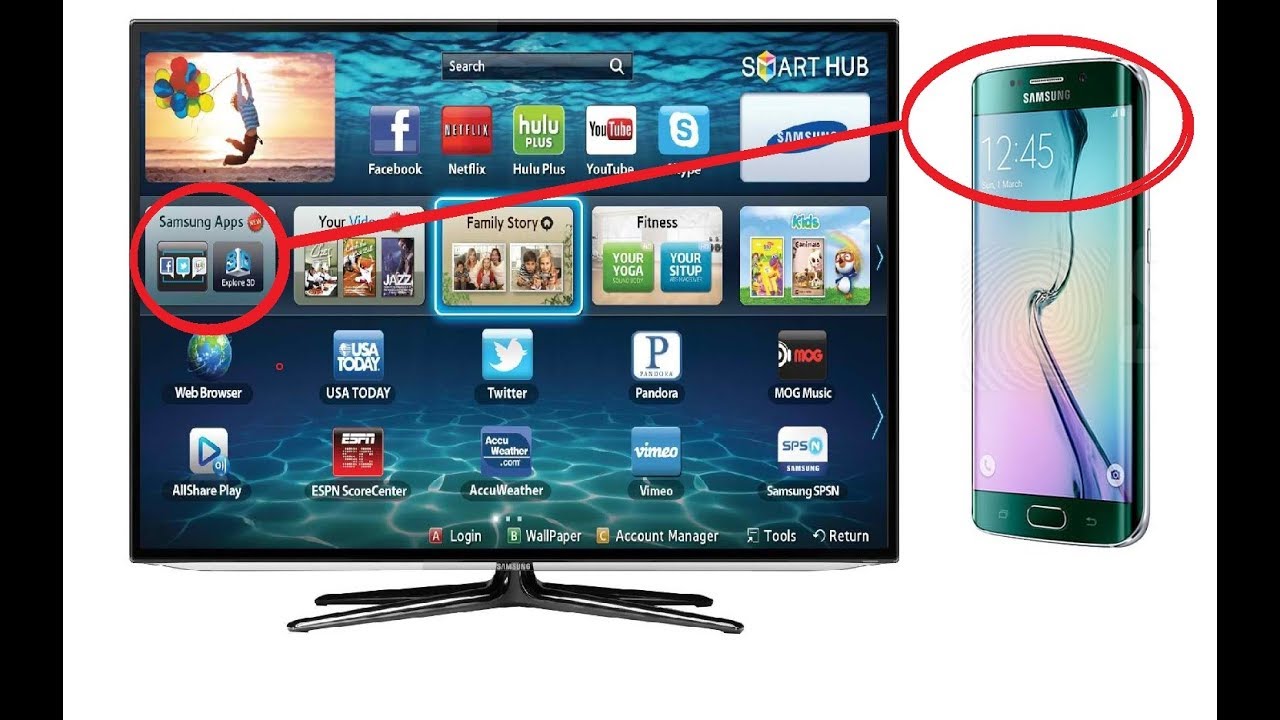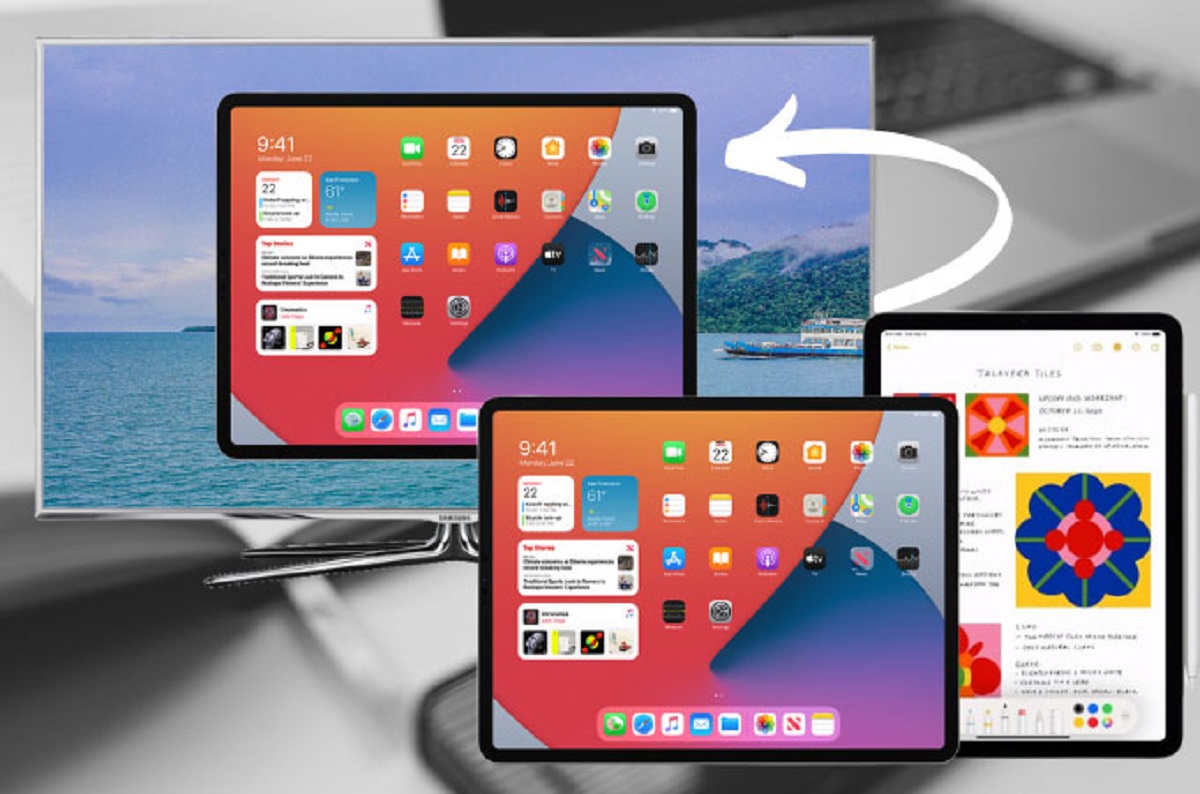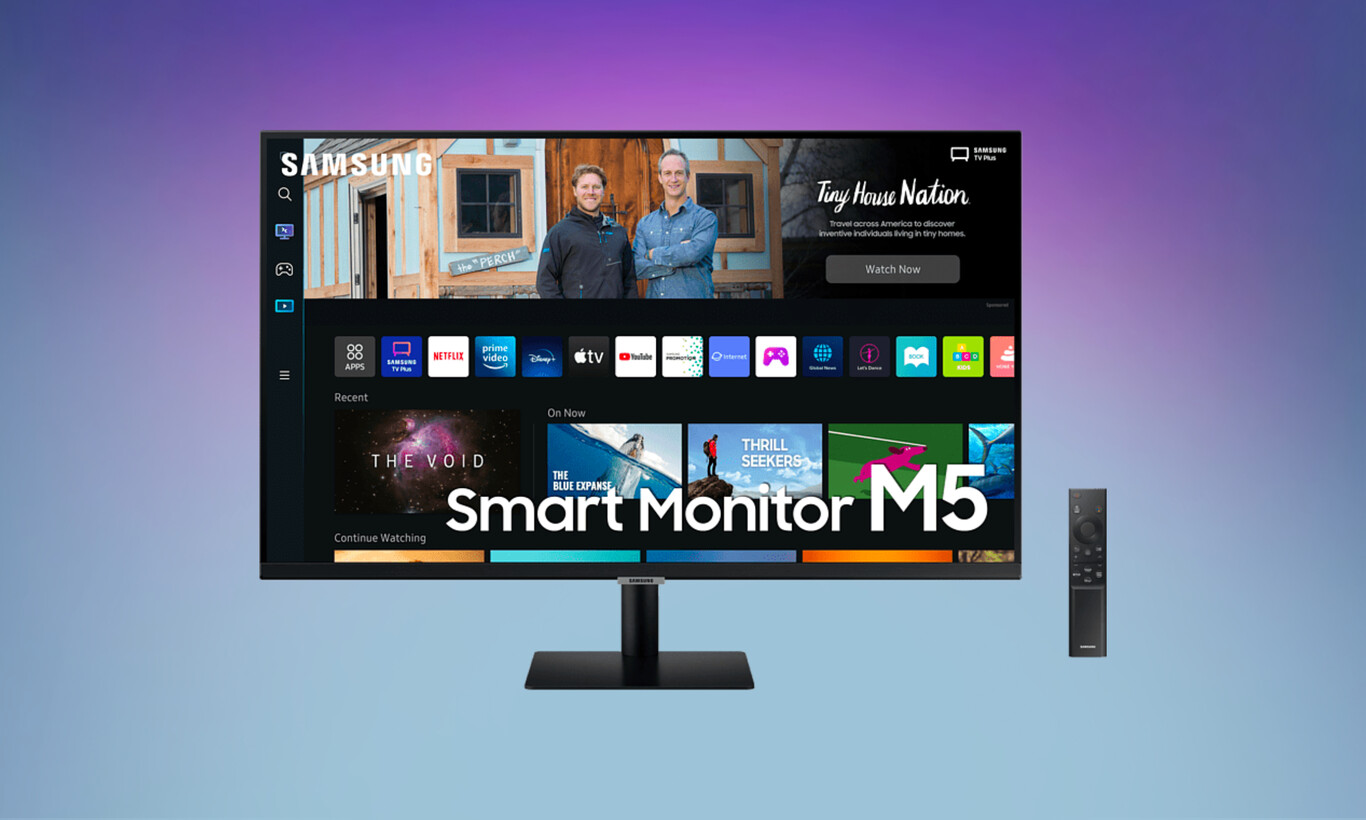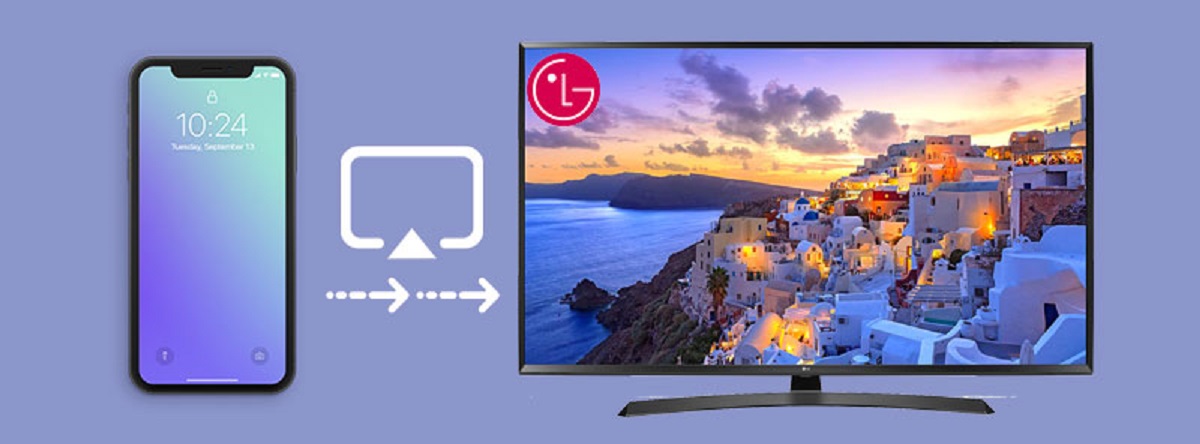Introduction
Welcome to the world of screen mirroring, where you can seamlessly display the content from your smartphone, tablet, or computer on a larger screen. Screen mirroring has become increasingly popular as it allows you to enjoy your favorite movies, photos, and videos on a bigger and more immersive display.
But what exactly is screen mirroring? How can you take advantage of this technology? In this article, we will explore the concept of screen mirroring, its benefits, and how you can easily connect your devices to a smart TV for an enhanced viewing experience.
Screen mirroring, also known as screen casting or screen sharing, refers to the process of replicating the display of one device onto another device, typically a smart TV. This means that whatever you see on your phone, tablet, or computer screen will be mirrored on the larger screen of your smart TV.
Nowadays, most smart TVs come with built-in screen mirroring capabilities, allowing you to wirelessly connect your devices and enjoy a more immersive viewing experience. Whether you want to stream a movie, play a game, give a presentation, or showcase your vacation photos, screen mirroring offers a convenient and versatile solution.
One of the main benefits of screen mirroring is the ability to enjoy content on a larger screen. It allows you to transform your smartphone or tablet into a portable entertainment center, creating a theater-like experience in the comfort of your own home. Moreover, screen mirroring is not limited to entertainment purposes; it is also a useful tool for business presentations, collaborative work, and educational activities.
Before we dive into the specifics of screen mirroring, it’s essential to choose the right smart TV that supports this feature. Not all smart TVs are created equal, and some may have limitations or compatibility issues with certain devices. In the next section, we will guide you through the process of selecting the perfect smart TV for your screen mirroring needs.
What is Screen Mirroring?
Screen mirroring, also referred to as screen casting or screen sharing, is a technology that allows you to mirror the display of one device onto another. In simpler terms, it enables you to project the screen of your smartphone, tablet, or computer onto a larger display, typically a smart TV.
By utilizing screen mirroring, you can view the content of your device on a bigger screen, transforming it into an immersive and engaging experience. Whether you want to watch movies, play games, share photos and videos, or give presentations, screen mirroring provides a convenient way to do so without compromising on quality.
The process of screen mirroring typically involves establishing a wireless connection between your device and the smart TV. This connection enables the real-time replication of the contents of your device onto the television screen.
There are various methods and technologies that enable screen mirroring, depending on the devices and platforms you are using. Here are some common screen mirroring methods:
- Wi-Fi Direct: This method utilizes Wi-Fi technology to establish a direct connection between your device and the smart TV, without the need for an internet connection. It offers a seamless and stable mirroring experience.
- Miracast: Miracast is a wireless display standard that enables screen mirroring between compatible devices. It allows you to mirror the display of your Android device, Windows PC, or other Miracast-enabled devices to a smart TV.
- AirPlay: AirPlay is an Apple-specific technology that allows you to mirror the screen of your iOS or macOS device onto an Apple TV or other compatible devices.
Screen mirroring is not limited to specific types of content. You can mirror anything that is displayed on your device, including apps, photos, videos, games, presentations, and more. This versatility makes it a valuable feature for entertainment, productivity, and collaboration purposes.
It’s worth noting that screen mirroring may have slight variations in functionality and availability across different devices and smart TV models. Therefore, it is important to ensure compatibility between your devices and choose a smart TV that supports your preferred method of screen mirroring.
Now that we have a basic understanding of screen mirroring and its capabilities, let’s explore the reasons why you should consider using screen mirroring in the next section.
Why Use Screen Mirroring?
Screen mirroring has become increasingly popular, and for good reason. It offers a multitude of benefits and advantages that enhance the overall user experience. Here are some compelling reasons to consider using screen mirroring:
1. Enhanced Viewing Experience
By using screen mirroring, you can enjoy your favorite content on a much larger screen. Whether you’re streaming a movie, playing a game, or viewing photos and videos, the larger display of a smart TV brings a whole new level of immersion and visual appeal. It allows you to fully immerse yourself in the content and enjoy it to the fullest.
2. Convenience and Versatility
Screen mirroring offers both convenience and versatility. It eliminates the need for cables and wire connections, offering a wireless and seamless way to connect your devices. You can easily switch between different devices, such as your smartphone, tablet, or computer, without the hassle of connecting and disconnecting cables. Additionally, screen mirroring is not limited to specific types of content, making it a versatile tool for entertainment, productivity, and collaboration purposes.
3. Sharing and Collaboration
Screen mirroring allows you to share content with others and collaborate more effectively. Whether it’s sharing a presentation in a meeting, showcasing photos and videos to friends and family, or collaborating on a project, screen mirroring enables everyone to view the same content simultaneously on a larger screen. This makes it easier to communicate ideas, gather feedback, and work together seamlessly.
4. Accessibility for All
Screen mirroring opens up new possibilities for individuals with accessibility needs. It allows people with visual impairments to enjoy content on a larger screen, making it easier to see and engage with. Additionally, individuals with mobility impairments can control the content on their devices from a distance, using the smart TV as a display and eliminating the need to manipulate small screens.
5. Gaming and Entertainment
If you’re an avid gamer or a movie enthusiast, screen mirroring can significantly enhance your gaming and entertainment experience. You can mirror mobile games or streaming services onto a larger screen, immersing yourself in the action and detail. It’s like having a portable gaming console or cinema right in your living room.
With these compelling reasons in mind, it’s evident that screen mirroring offers numerous advantages that can greatly enhance your digital lifestyle. Now that you understand the benefits, it’s important to choose a smart TV that is compatible with your devices and supports screen mirroring. In the next section, we will guide you through the process of selecting the right smart TV for your screen mirroring needs.
Choosing the Right Smart TV for Screen Mirroring
When it comes to screen mirroring, choosing the right smart TV is crucial to ensure a seamless and hassle-free experience. Here are some key factors to consider when selecting a smart TV for screen mirroring:
1. Compatibility
Ensure that the smart TV you choose is compatible with the devices you plan to mirror. Different smart TVs and devices may support various screen mirroring technologies, such as Wi-Fi Direct, Miracast, or AirPlay. It’s important to check the compatibility requirements of your devices and choose a smart TV that supports the appropriate technology.
2. Connectivity Options
Consider the connectivity options available on the smart TV. Most modern smart TVs are equipped with built-in Wi-Fi, which allows for wireless connections. However, it’s also beneficial to have additional connectivity options, such as HDMI or USB ports, to ensure compatibility with various devices and connection methods.
3. Picture Quality and Display Features
Pay attention to the picture quality and display features of the smart TV. Look for a TV with high resolution, such as 4K or Full HD, to ensure a crisp and detailed display. Additionally, consider features like HDR (High Dynamic Range) and a wide color gamut for a more vibrant and lifelike viewing experience.
4. User Interface and Operating System
Consider the user interface and the operating system of the smart TV. A user-friendly interface and a responsive operating system can greatly enhance your overall experience. Look for a smart TV with an intuitive interface that allows for easy navigation and access to desired settings and applications.
5. App Support
Check the availability and support for popular streaming and screen mirroring apps on the smart TV. Ensure that the TV supports the apps you frequently use, such as Netflix, YouTube, or screen mirroring apps specific to your device’s operating system. This will ensure that you have access to a wide range of content and features.
6. Brand Reputation and Customer Reviews
Consider the reputation of the brand and read customer reviews before making your final decision. A well-established brand with positive reviews often indicates a reliable and high-quality product. Take the time to research and read feedback from other users to get a better understanding of the smart TV’s performance and reliability.
By taking these factors into account, you can narrow down the options and choose a smart TV that best suits your screen mirroring needs. Once you have selected the perfect smart TV, you’re ready to connect your device and start enjoying the benefits of screen mirroring. In the following sections, we will guide you through the process of connecting and mirroring your Android, iOS, and Windows devices to a smart TV.
Connecting Your Device to the Smart TV
Once you have chosen the right smart TV for screen mirroring, the next step is to establish a connection between your device and the TV. The process may vary slightly depending on the type of device you are using, but the general steps are as follows:
1. Ensure Both Devices are Connected to the Same Wi-Fi Network
Before you begin, make sure that both your device and the smart TV are connected to the same Wi-Fi network. This is essential to establish a wireless connection between the two devices.
2. Enable Screen Mirroring on the Smart TV
On your smart TV, navigate to the settings and look for the screen mirroring or casting option. Enable this feature to allow your device to connect to the TV.
3. Enable Screen Mirroring on Your Device
On your device, go to the settings and find the screen mirroring or casting option. Depending on the device and operating system, this option may be labeled differently. Enable screen mirroring on your device to initiate the connection process.
4. Select the Smart TV
Once screen mirroring is enabled on both devices, your device will scan for available devices to connect to. You should see the name of your smart TV on the list. Tap or select the name of your TV to establish the connection.
5. Confirm Connection on the Smart TV
On your smart TV, you might need to confirm the connection request from your device. Look for a notification or prompt on the TV screen and follow the on-screen instructions to confirm the connection.
6. Start Screen Mirroring
Once the connection is established, your device’s screen will start mirroring onto the smart TV. You can now enjoy your favorite content on the larger screen, whether it’s streaming movies, playing games, or viewing photos and videos.
Note that the specific steps may vary depending on the device and smart TV model you are using. It’s always a good idea to refer to the user manual or consult the manufacturer’s website for detailed instructions specific to your devices.
Now that your device is successfully connected to the smart TV, you can explore the various screen mirroring features and settings available. In the next sections, we will guide you through the process of screen mirroring on different devices, including Android, iOS, and Windows.
Screen Mirroring on Android Devices
If you have an Android device, screen mirroring to a smart TV is relatively straightforward. Follow these steps to mirror your Android device to the smart TV:
1. Enable Screen Mirroring on Your Android Device
Open the settings on your Android device and look for the screen mirroring, cast, or wireless display option. The exact name may vary depending on the device and Android version. Enable this feature to start the screen mirroring process.
2. Connect to your Smart TV
On your Android device, a list of available devices will be displayed. Select your smart TV from the list to initiate the connection.
3. Confirm Connection on the Smart TV
On your smart TV, you might need to confirm the connection request from your Android device. Look for a notification or prompt on the TV screen and follow the on-screen instructions to confirm the connection.
4. Start Screen Mirroring
Once the connection is established, your Android device’s screen will be mirrored on the smart TV. You can now enjoy your favorite content on the larger screen.
5. Adjust Settings and Display Options
Depending on your smart TV model, you may have additional settings and display options to customize your screen mirroring experience. You can adjust the display resolution, screen orientation, or even enable extended display mode for multitasking.
It’s important to note that the steps above are a general guideline, and the options and settings may vary depending on the Android device and smart TV you are using. If you encounter any issues or need further assistance, refer to the user manual or the manufacturer’s instructions specific to your devices.
With your Android device connected to the smart TV, you can now enjoy streaming movies, playing games, sharing photos, and much more on the big screen. In the next section, we will explore how to mirror your iOS devices to a smart TV.
Screen Mirroring on iOS Devices
If you have an iOS device, such as an iPhone or iPad, screen mirroring to a smart TV can be done using Apple’s AirPlay technology. Here’s how you can mirror your iOS device to a smart TV:
1. Ensure AirPlay is Supported on Your Smart TV
Before you begin, make sure your smart TV supports AirPlay. Not all smart TVs are compatible with AirPlay, so it’s important to check if your TV model supports this feature.
2. Connect Your iOS Device and Smart TV to the Same Wi-Fi Network
Ensure that both your iOS device and the smart TV are connected to the same Wi-Fi network. This is crucial for establishing a connection between the two devices.
3. Open Control Center on Your iOS Device
Swipe down from the top-right corner of the screen (on iPhone X or later) or swipe up from the bottom of the screen (on older iPhone models and iPads) to access Control Center.
4. Tap on the Screen Mirroring Icon
In Control Center, you will see a Screen Mirroring or AirPlay icon. Tap on the icon to open the screen mirroring settings.
5. Select your Smart TV’s Name
A list of available AirPlay devices will be displayed. Select your smart TV’s name from the list to start the screen mirroring process.
6. Enter the AirPlay Code (if prompted)
Depending on your smart TV model, you may be prompted to enter an AirPlay code displayed on the TV screen, or you may need to confirm the connection request on the smart TV.
7. Start Screen Mirroring
Once the connection is established, your iOS device’s screen will be mirrored on the smart TV. You can now enjoy viewing your iOS device’s content on the larger screen.
Please note that the steps mentioned above are a general guide, and the options and settings may vary depending on your iOS device and smart TV model. If you encounter any issues or need further assistance, refer to the user manual or consult the manufacturer’s instructions specific to your devices.
With your iOS device successfully connected and screen mirroring enabled, you can now enjoy streaming videos, sharing photos, giving presentations, and more on the big screen of your smart TV. In the next section, we will explore how to mirror Windows devices to a smart TV.
Screen Mirroring on Windows Devices
If you have a Windows device, such as a laptop or PC, you can easily mirror your screen to a smart TV using several methods. Here’s how you can screen mirror your Windows device to a smart TV:
1. Use Miracast
Windows devices often support Miracast, a wireless display standard that allows for screen mirroring on compatible devices. Here’s how to use Miracast:
- On your Windows device, open the Action Center by clicking on the Notification icon in the system tray or swiping in from the right side of the screen.
- Click on the Project icon, which looks like a monitor with a rectangle and lines next to it.
- Select ‘Connect to a Wireless Display’ from the options.
- Your Windows device will search for available devices. Select your smart TV from the list to establish the connection.
- Once connected, your Windows device’s screen will be mirrored on the smart TV, allowing you to view your content on a larger display.
2. Use HDMI Cable
If your Windows device and smart TV have an HDMI port, you can use an HDMI cable to connect the two directly. Here’s how:
- Connect one end of the HDMI cable to your Windows device’s HDMI output port.
- Connect the other end of the HDMI cable to the HDMI input port on your smart TV.
- Use your TV remote to switch the input source to the correct HDMI port.
- Your Windows device’s screen will be mirrored on the smart TV, and you can now view your content on the larger screen.
3. Use Casting Apps
You can also use casting apps available for Windows devices to facilitate screen mirroring. These apps utilize wireless connectivity to mirror your screen onto the smart TV. Some popular casting apps include:
- Microsoft Wireless Display Adapter
- Plex
- Cast to TV
- VLC Media Player with cast functionality
When using casting apps, make sure that your Windows device and smart TV are connected to the same Wi-Fi network for seamless connectivity.
It’s worth noting that the steps mentioned above may vary slightly depending on your specific Windows device and smart TV model. It’s always a good idea to refer to the user manual or the manufacturer’s instructions for detailed guidance.
With your Windows device successfully connected and screen mirroring enabled, you can now enjoy streaming videos, giving presentations, gaming, and more on the big screen of your smart TV. In the next section, we will provide some troubleshooting tips for common screen mirroring issues.
Troubleshooting Common Screen Mirroring Issues
While screen mirroring is a convenient and powerful feature, it may encounter some issues that can hinder the smooth mirroring experience. Here are some common problems you may encounter and troubleshooting steps to resolve them:
1. Connection Issues
If you’re experiencing difficulty connecting your device to the smart TV, try the following:
– Ensure that both your device and the smart TV are connected to the same Wi-Fi network.
– Restart your device and smart TV to refresh their network connections.
– Update the firmware of your smart TV to the latest version.
– Disable any VPNs or proxy settings on your device, as they may interfere with the connection.
2. Audio or Video Lag
If you notice a delay or lag between the audio and video while screen mirroring, try the following:
– Make sure your device and smart TV are within range of a strong Wi-Fi connection to avoid signal interference.
– Reduce the distance between your device and the smart TV to improve connection stability.
– Restart your router to ensure optimal Wi-Fi performance.
– Disconnect other devices from the Wi-Fi network to free up bandwidth for the screen mirroring process.
– Disable any power-saving settings on your device that may affect screen mirroring performance.
3. Incompatible Device or App
If you’re unable to screen mirror due to compatibility issues, consider the following steps:
– Ensure that your device and smart TV support the same screen mirroring technology (e.g., Miracast, AirPlay).
– Update your device’s operating system and smart TV’s firmware to the latest versions.
– Check if your specific app or content is compatible with screen mirroring. Some apps may not support this feature due to DRM restrictions.
4. Poor Picture Quality
If the picture quality during screen mirroring appears poor, follow these suggestions:
– Ensure that both your device and smart TV support the desired resolution for optimal picture quality.
– Adjust the display settings on your device or smart TV to optimize the picture quality.
– Check the HDMI cable (if used) for any damage or try using a different cable for a better connection.
5. Audio Not Playing on TV
If you’re encountering issues with the audio not playing on the smart TV, try the following:
– Check the audio output settings on your device and make sure it’s set to the correct output source (e.g., TV speakers).
– Adjust the volume settings on both your device and smart TV to ensure they are not muted or set too low.
If the above troubleshooting steps do not resolve the issue, consult the user manual, manufacturer’s website, or customer support for your specific device or smart TV for further assistance.
With these troubleshooting tips in mind, you should be able to overcome common screen mirroring issues and enjoy a seamless mirroring experience. In the next section, we will wrap up this article with a summary and key takeaways.
Conclusion
Screen mirroring offers a convenient and versatile way to enjoy your favorite content on a larger screen. Whether you have an Android device, an iOS device, or a Windows device, screen mirroring allows you to transform your smartphone, tablet, or computer into a powerful entertainment hub.
In this article, we explored the concept of screen mirroring and its benefits. We discussed the importance of choosing the right smart TV that supports screen mirroring and shared tips for connecting your device to the TV. We also covered the specific steps for screen mirroring on Android, iOS, and Windows devices.
While screen mirroring provides an immersive viewing experience, it’s important to troubleshoot common issues that may arise. We provided troubleshooting tips for connection issues, audio or video lag, compatibility problems, poor picture quality, and audio playback problems.
By following the guidelines and troubleshooting steps outlined in this article, you can overcome barriers and enjoy seamless screen mirroring. Whether you want to stream movies, play games, share photos and videos, or give presentations, screen mirroring offers a convenient and enjoyable way to do so on a larger, more immersive display.
Remember to refer to the user manuals and manufacturer instructions for detailed guidance specific to your devices. Additionally, stay updated with the latest software updates and firmware versions to ensure compatibility and optimal performance.
So, why wait? Grab your popcorn, mirror that screen, and indulge in an enhanced entertainment experience with screen mirroring on your smart TV!







